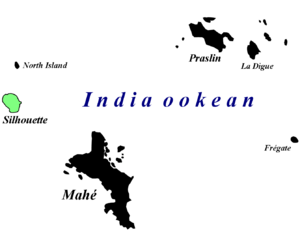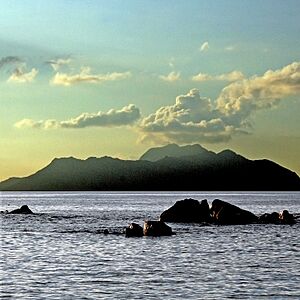Seychelles forest scorpion facts for kids
Quick facts for kids Seychelles forest scorpion |
|
|---|---|
| Conservation status | |
| Scientific classification | |
 |
|
| Silhouette Island and the neighboring islands | |
| Synonyms | |
|
The Seychelles forest scorpion (scientific name: Afrolychas braueri) is a type of scorpion. It belongs to the Buthidae family. This special scorpion is believed to live only on Silhouette Island in the Seychelles. However, long ago, it also lived on two other islands there.
This scorpion likes to live in forests where the ground is covered with fallen leaves. These are forests that haven't been taken over by plants from other places. The Seychelles forest scorpion is small and yellowish-brown. It has three clear ridges on its back, which helps tell it apart from other scorpions. Not much is known about how it lives because it's rarely seen. But we do know it uses its venom to catch food and protect its babies. Don't worry, its venom is not harmful to people.
The Seychelles forest scorpion has been seen only a few times. This means there aren't many of them left. It is listed as a critically endangered species by the International Union for Conservation of Nature. This makes it one of the most endangered scorpions in the world. Its biggest threat is plants from other places, especially a type of cinnamon tree. These plants are destroying its home. The area where it lives is protected by Silhouette National Park. People are now working to restore the plants and remove the cinnamon trees to help save this scorpion.
Contents
What is the Seychelles Forest Scorpion?
The Seychelles forest scorpion was first described in 1896 by a scientist named Karl Kraepelin. He called it Archisometrus braueri. Later, in 1913, it was moved to a different group called Lychas. Scientists thought this group might include too many different types of scorpions.
In 2019, this scorpion got its own new group, Afrolychas. Another scorpion from Africa, Afrolychas burdoi, is its closest relative. The name Afrolychas shows that these scorpions live in Africa and used to be in the Lychas group. The name braueri honors August Brauer. He was a German scientist who collected the first scorpions in the Seychelles.
The first scorpion of this kind was found on Praslin Island in 1894. It is now kept at a museum in Germany. The scorpion was later found in "high jungle" on Mahé and Silhouette islands in 1905. After that, it wasn't seen again until 1990 on Silhouette Island.
What Does the Seychelles Forest Scorpion Look Like?
The Seychelles forest scorpion is small. It is about 25 to 36 mm (0.98 to 1.42 in) long. That's about the length of your thumb! It is yellowish-brown with blotches. The best way to tell it apart is by the three clear ridges on its back.
Its pincers, called pedipalps, have special cutting edges. These edges are smooth, without tiny bumps. The scorpion's tail, called a metasoma, is shiny. Its stinger, called a telson, is quite long. It has special comb-like organs called pectens with 14 to 18 "teeth." Male and female scorpions look very similar. Remember, its sting is not dangerous for humans.
Where Does the Seychelles Forest Scorpion Live?
The Afrolychas braueri scorpion is currently known to live in a small forest area of about 5 km2 (1,200 acres) on Silhouette Island in the Seychelles. It is one of only three types of scorpions found in the Seychelles. It lives at higher places on the island, between 500 and 550 m (1,640 and 1,800 ft) high.
Historically, this scorpion was found only in the Seychelles. It used to live on Mahé island, but plants from other places caused it to disappear there. The Seychelles forest scorpion lives in very small numbers.
It lives in forests where the ground is covered with leaves. These forests still have their natural plants, like Dillenia ferruginea. The scorpions hide under stones and logs.
How Does the Seychelles Forest Scorpion Live?
An ant species from other places, Technomyrmex albipes, has been known to kill Seychelles forest scorpions. Like all scorpions in its family, the Seychelles forest scorpion uses only its venom to catch its food.
In June 2009, a female scorpion was found carrying seven baby scorpions on her back. Like other scorpions, she would take care of them until they were old enough to live on their own.
How Are We Protecting the Seychelles Forest Scorpion?
The Seychelles forest scorpion was listed as critically endangered in 2012. This means it is at very high risk of disappearing forever. It is only known from a small forest area on Silhouette Island. This area is being harmed by plants from other places, especially the cinnamon tree.
Scientists think this scorpion disappeared from Mahé and Praslin islands after 1909. This was because invasive plants took over its home. It might also be threatened by an invasive ant species. Since 1909, the scorpion has only been seen three times: in 1990, 2006, and 2009. All these sightings were on Silhouette Island. It's hard to find them, and many searches have failed.
The area where the scorpions live is part of Silhouette National Park. In 2012, the park was not actively managed to protect the scorpion. However, since then, the Island Conservation Society has started projects on the island. These projects include restoring natural plants and removing the harmful cinnamon trees. These efforts are helping to protect this rare scorpion.



